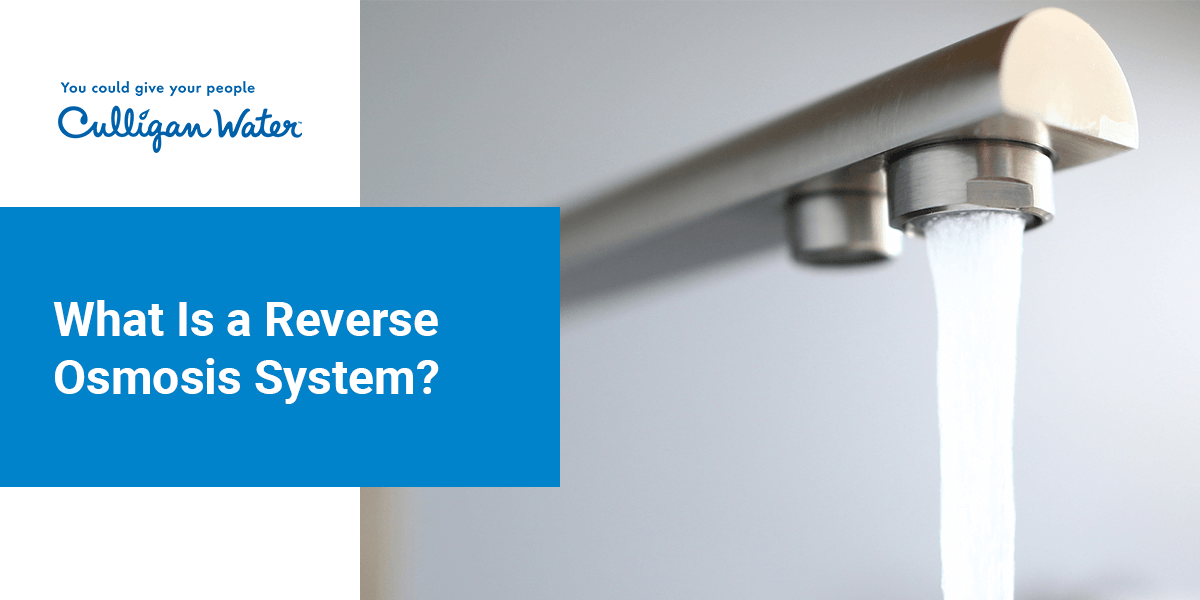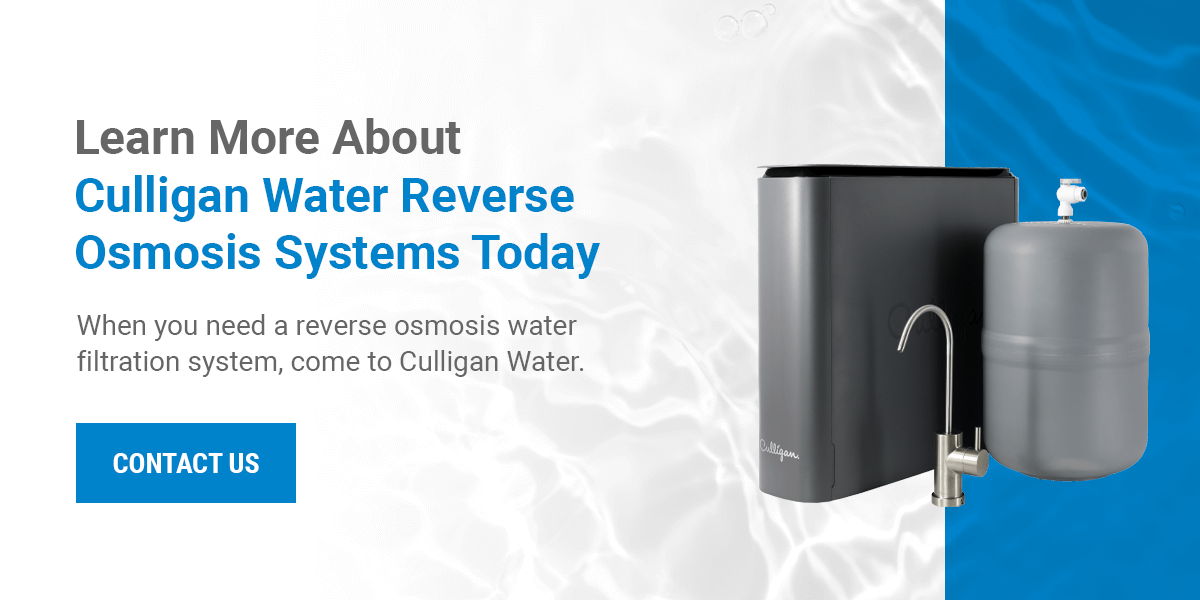Table of Contents

What Is a Reverse Osmosis System?
Reverse osmosis (RO) systems are a popular way for homeowners and businesses to filter water. The RO process has been used by municipalities as far back as 1977. It is a cost-effective system that requires low maintenance. Almost all reverse osmosis systems have the same components, including:
- A cold water line valve
- Pre-filters
- A RO membrane
- Post filters
- An automatic shut off valve
- A check valve
- A flow restrictor
- A storage tank
- A faucet
- A drain line
Many people who use well water or city and town water systems benefit from having a reverse osmosis system in their homes.
How Does a Reverse Osmosis System Work?
RO systems are relatively simple. The water from your source is pushed across a semi-permeable membrane after pressurizing it using the existing water pressure from your supply source (well or city water). This action leaves behind the contaminants from the water, which are then flushed away. A holding tank stores all the clean, filtered water.
When the water is pushed through the semi-permeable membrane, any dissolved inorganic solids are removed from the final product. The water often passes through several filters in the reverse osmosis process until it is collected in a holding tank.
If you have an RO system in your home, it is generally installed beneath your kitchen sink or in the basement if this space is in close proximity to your kitchen sink or another point of use. The water within the RO system will enter the following phases:
- Pre-filtration: Reduces fine materials suspended in the water, like sand or dirt, capable of clogging the RO system.
- Carbon filtration: Removes otherwise unpleasant tastes or odors, including chlorine.
- Semi-permeable membrane: May remove contaminants and aesthetically undesirable particles, including extremely small particles the size of an atom.
- Specialty filtration: Eliminates other particles, such as organic compounds like bacteria, viruses or pharmaceuticals.
- Customizable options: Add certain types of minerals back into your water, such as calcium. This step can also increase the water’s pH levels.
- Polishing: Makes your water taste fresh and crisp.
Is a Reverse Osmosis System a Good Filter Option for My Home?
Reverse osmosis filtration systems offer numerous benefits for homeowners. Choose an RO system to reap many advantages, including:
- Improvement in your water’s taste: A reverse osmosis system can remove contaminants that affect your water’s taste, appearance and odor, enhancing your drinking experience.
- Simple maintenance measures: RO systems have few parts that move or need replacing often, making them simple to maintain over time. Some RO systems have smart sensors to let you know when components need servicing. Many RO systems can last over 10 years when cared for properly.
- A cost-effective solution: Reverse osmosis allows you to get the clean, purified water you want without paying for more complex filtration systems or bottled water.
- Pollutant removal: An RO system may remove several types of contaminants and pollutants with its semi-permeable membrane and other filters.
- Fewer energy requirements: An RO system needs less energy generation to operate than several other filtration methods.
- Reduced plastic waste: A homeowner or family no longer has to buy water bottles to receive tasty filtered water since it can come directly from the sink.
- Less sodium: People on sodium- and salt-restricted diets can enjoy drinking water from the tap when using an RO system.
- A conveniently small size: An RO system is space-saving because it can fit right underneath your sink.
- Automated work: Reverse osmosis systems are simple to use — they will do all the work for you. Aside from maintenance and general upkeep, there is nothing else for you to do except enjoy fresh water.
What Does a Reverse Osmosis System Remove?
Many reverse osmosis systems can remove up to 95% of contaminants and other unwanted substances. Some of the substances RO systems can remove include:
- Nitrates
- Sulfates
- Pesticides
- Lead
- Fluoride
- Chlorine and chloramine
- Detergents
- Calcium
- Dyes
- Phosphates
- Sodium
- Sediment
- Arsenic
- Mercury
- Nickel
- Barium
Some substances — such as fluoride or calcium — are intentionally added to water, so keep that in mind when choosing an RO system. However, if you don’t want these materials in your water, there’s no issue with using reverse osmosis because it may remove any other problematic contaminants and bacteria.
Where Can I Use an RO System in My Home?
Reverse osmosis systems often serve the primary application of supplying drinking water to a home. However, you can use this type of water in several other ways, including the following:
- Supplying ice machines
- Cleaning
- Cooking
- Making coffee or tea
- Filling aquariums and fish tanks
- Washing fruits and vegetables
- Giving it to your pets
RO water can accommodate almost any task in your home because it is pure and filtered. You can easily use RO water for any reason, whether you only need it for cooking and drinking or want to let your dogs drink it.
Learn More About Culligan Water Reverse Osmosis Systems Today
When you need a reverse osmosis water filtration system, come to Culligan Water. Our products help solve challenging and complex water issues, including purification and filtering for household use.
We help all of our clients find the specific products they need for water filtration. Our team will test your water and recommend a filtration system that will work best for you, and we’ll help you customize a reverse osmosis system to fit your exact needs.
Our RO systems are affordably priced and come with the added benefit of experienced technicians who can help with installation and maintenance. We also offer financing solutions and a 30-day money-back guarantee for our products.
If you’d like to learn more about Culligan Water reverse osmosis systems, please contact our team online today, and we’ll be more than happy to assist.

